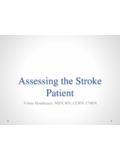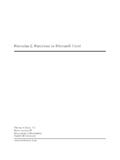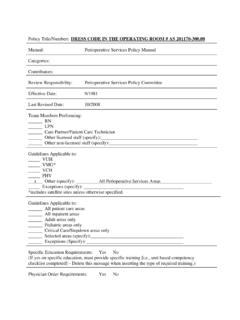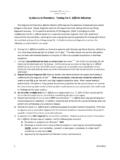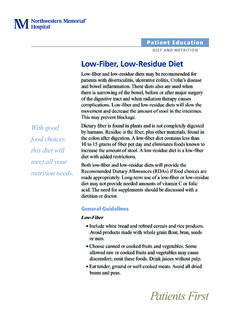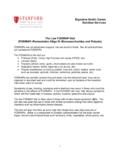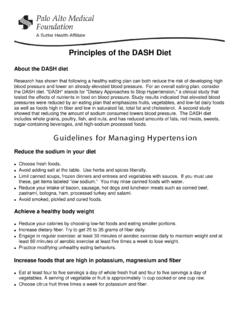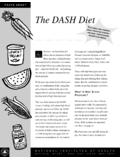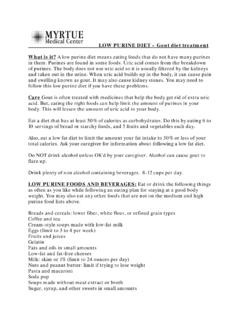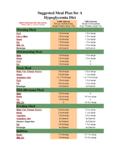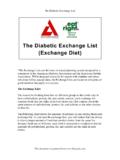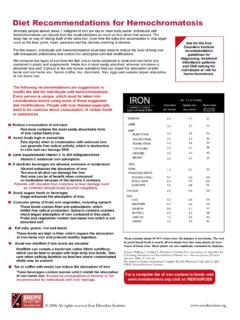Transcription of LOW FIBER, LOW BULK DIET - mc.vanderbilt.edu
1 LOW FIBER, LOW BULK diet FOOD GROUP FOODS RECOMMENDED FOODS THAT MAY CAUSE DISTRESS Grains: Breads, Pasta, Cereals Refined breads, rolls, biscuits and crackers (low fat). Refined ready to eat cereals such as farina. Refined cold cereals such as corn flakes, Rice Krispies. White rice, refined pasta. Any bread or cereal made with whole grain flour, bran, seeds, nuts, coconut, or dried fruit. Cereals such as bran flakes, shredded wheat or oatmeal. Breads such as whole wheat, 7-grain, oatmeal or cornbread. Graham crackers. Quickbread. Eggs, cheese, muffins, waffles, sweet rolls, pancakes or French toast. Fruits (remove skin) Canned or cooked fruits. Ripe bananas. Fruit juice (no pulp). Raw or dried fruit. All berries. Prune juice. Vegetables (remove skin) Canned or well cooked vegetables without seeds. Lettuce. Vegetable juice (no pulp). Raw vegetables and any with seeds.
2 Sauerkraut, winter squash, peas, corn (buttered or creamed). Pork & beans. Meat, Poultry, Fish, Eggs, Nuts, Dried Beans, Peas, Lentils (limit 6 oz a day) Well cooked tender beef, lamb, ham, veal, pork, poultry, and fish. Eggs, 1 per day. Water packed tuna and salmon. Egg whites or substitutes. Tough fibrous meats with gristle or any prepared with whole grains, nuts, or seeds. Dried beans, peas, lentils. Peanut butter. Canned or frozen in sauces, gravy. Lunch meats, hotdogs, or corned beef. Milk, Yogurt, Cheese Milk, yogurt, mild cheese (low fat or fat free). Cottage cheese (low fat or fat free). Snacks/Desserts Plan, low fat sherbet, fruit ice, jello, custard, marshmallows, hard candy, ice cream (fat free). Pudding (made from skim milk). Angel food cake, cookies (small amt of fat, vanilla wafers or ginger snaps). Any made with whole wheat flour, bran, seeds, nuts, dried fruit, or coconut.
3 Popcorn, nuts, seeds. Commercial cakes, pies, cookies, ice cream, ice milk Fats, Condiments, Beverages Margarine, butter, oil, mayonnaise, salad dressing (limit 2 tsp daily). Boullion, broth, soup made with allowed ingredients. Cream soup made from fat free skim milk, broth based soup. Coffee, tea, and carbonated beverages. Herbs, and powdered spices. Canned soups. Nuts, coconuts, chocolate, olives, potato chips. GASTROPARESIS diet TIPS Introduction Gastroparesis means stomach (gastro) paralysis (paresis). The word Gastroparesis is used when a patient s stomach empties too slowly. Everyone s stomach is unique, so the ability of the stomach to empty can vary from one patient to another. Most patients are able to swallow and empty their saliva (about 1 quart per day) and also empty the natural stomach juices they make (about 2-3 quarts per day). Symptoms can vary from week to week or even day to day.
4 The guidelines presented here are designed to give tips for diet modification. In addition, lots of suggestions are provided for foods and fluids to try when ideas run dry at home. The suggestions are based on experience and not science, as there are no studies that have been done that demonstrate what foods are better tolerated than others by patients with Gastroparesis. It is recommended that anyone with Gastroparesis see their doctor and their Registered Dietician to see advice on how to maximize their diet . The Basics Volume The larger the meal, the slower the stomach emptying will be. Patients will need to decrease the volume of their meals, but in order to meet nutrient needs, they will have to eat more often. Smaller, more frequent meals (6-8 or more if necessary) may allow patients to meet their needs. Liquids Vs. Solids If decreasing the meal size and increasing the number of meals does not work, the next step is to switch over to more liquid type calories.
5 Liquids are better tolerated than solids. Liquids empty the stomach in a different way than solids do. Pureed foods mixed with saliva and stomach juices are more tolerated. Fiber Fiber (found in many fruits, vegetables, and grains) may act to slow stomach emptying in some patients and fill them up so quickly that, nutrient needs may not be met. For patients who have a bezoar (similar to a hair ball in a cat) in the past, a fiber restriction (including avoidance of over the counter fiber/bulking laxatives see table one) is worthwhile. Patients who have required jejunal tube feedings generally tolerate fiber containing formulas as the stomach is bypassed. Fat Although fat may slow stomach emptying in some patients, many can consume fat especially in the form of liquids. Although many clinicians restrict fat, my experience is that fat in the liquid form (as part of beverages such as whole milk, milkshakes, nutritional supplements, etc.)
6 Is often well tolerated. To restrict fat in the diet of a patient who is severely malnourished is to remove a valuable calorie source. Unless a fat containing food or fluid clearly seems problematic, fat should not be limited. It is often well tolerated, pleasureable, and it provides a great source of calories in small amounts. Medication There are quite a few medicatiosn that can delay stomach emptying ask your doctor if any of the medications you are on could be slowing down your stomach emptying. Getting Started Eat six or more small meals per day and avoid large meals. Avoid foods high in fat or too much fat added to foods (liquid fat in beverages is often tolerated). Eat nutritious foods first before filling up on empty calories . Chew foods well; especially meats. (Meats may be more tolerated if ground or pureed) Avoid high fiber foods because they may be more difficult for your stomach to empty or may cause bezoar formation.
7 A bezoar is a mixture of food fibers that may get stuck in the stomach and not empty well (similar to a hairball in a cat). Sit up while eating and for 1 hour after finishing; consider taking a quiet walk after meals. If you have diabetes, try to keep your blood sugar under control. Let your doctor knox if your blood sugar runs >200 on a regular basis. Try Blenderized Food Any food can be blenderized, but solid foods will need to be thinned with some type of liquid. o Meats, fish, poultry, and ham: Blend with broths, water, milk, vegetable or V-* juice, tomato sauce, gravies. o Vegetables: Blend with water, tomato juice, broths, strained baby vegetables. o Starches: Potatoes, pasta Blend with soups, broth, milk, water, gravies; add strained baby meats, etc. to add protein if needed. Consider using hot cereals such as cream of wheat or rice, grits, etc.
8 As your starch at lunch and dinner. o Fruits: Blend with their own juices, other fruit juices, water, strained baby fruits. o Cereals: Make with calorie beverage such as whole milk., soy or rice milk, juice, Ensure, or quivalent, etc., instead of water. Add sugars, honey, molasses, syrups, or other flavorings, butter or margarine for extra calories. o Mixed dishes: Lasagna, macaroni and cheese, spaghetti, chili, chop suey-add adequate liquid of your choice, blend well and strain. If you do not have a blender, strained baby foods will work and can be thinned down as needed with milk, soy or rice milk, water, broth, etc. Always clean the blender well. Any food left on the blender could cause food poisoning. Getting Your Calories When getting enough calories is a daily High calorie drinks are better than water (provide calories AND fluid); use peach, pear or papaya nectar, cranberry juice, orange juice, Hawaiian Punch, Hi-C, lemonade, Kool-Aid.
9 Fortify milk by adding dry milk powder 1 cup powder to 1 quart milk. Use whole milk or evaporated milk (if tolerated) instead of skim or 2 % for drinking and preparing cream type soups, custards, puddings, and milkshakes. Add instant breakfast, protein powder, dry milk powder, or other flavored powders or syrups to whole milk or juices. Make custards and puddings with eggs or egg substitutes (such as Eggbeaters). Try adding ice cream, sherbets, sorbets to ready-made supplements such as Nutrashakes, Ensure, or Boost. FOOD RELATED TIPS FOR GASTROPARESIS Starches Breads Cereals Grains/Potatoes Crackers White Bread Quick Oats (plain) Rice (plain) Arrowroot Bagels (plain or egg) Grits Pasta (plain) Breadsticks English Muffin Cream of Wheat Bulgur Matzoh Plain Roll Cream of Rice Barley Melba Toast Pita Bread Puffed wheat and rice Potatoes Oyster Tortilla (flour)
10 French Fries Pretzels Pancake Saltines Waffle Soda Zwieback Meats, Ground and Pureed Beef Pork Fish/Shellfish Cheese Baby Beef Lean Pork Crab Cottage Cheese Chipped Beef Tenderloin Lobster Grated Parmesan Flank Steak Pork Chops Shrimp Tenderloin 97% fat-free ham Clams Other Plate Skirt Steak Scallops Eggs (no creamed Round (bottom or top) Poultry (skinless) Oysters Tofu Rump Chicken Tuna (in water) Strained Baby Meats (all) Turkey (all))
